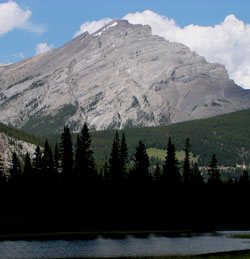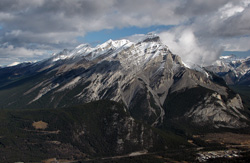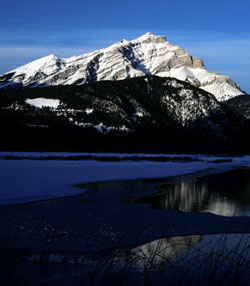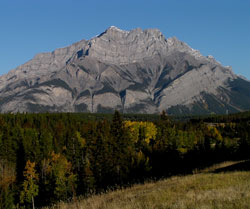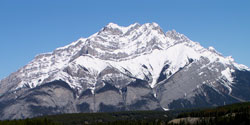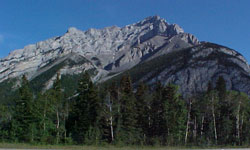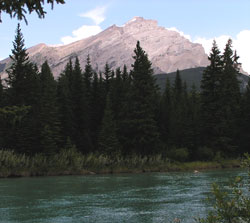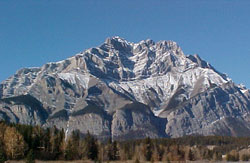
Photo: Looking northwest to Cascade Mountain from Highway #1 a few kilometres east of Banff townsite
Cascade Mountain
- 2998 m (9,836ft)
- First Ascent
- Naming History
Located in the Bow River Valley west of Cascade River; north of Banff townsite
Province: Alberta
Park: Banff
Headwater: Bow
Major Valley: Bow
Visible from Highway: 1
Ascent Party: L.B. Stewart, Tom Wilson
Named by: James Hector
Named for: The mountain is named for the cascade or waterfall on its southern cliffs.
People have been admiring the cascade on Cascade Mountain for a long time. The native name for the peak was, "Minihapa" which translates to "Mountain Where the Water Falls." Sir George Simpson passed by Cascade Mountain in 1841 noting, "a stream of water which, though of very considerable volume, looked like a thread of silver on the grey rock." When Father Pierre-Jean Pierre-Jean De Smet visited the area in 1845 he wrote that a, "beautiful crystalline fountain issues from the centre of a perpendicular rock about five hundred feet high, and then pours its water over the plain in foam and mist." On August 15, 1858, James Hector's party reached, "a beautiful little prairie at the base of the 'Mountain Where the Water Falls,' or the Cascade Mountain." The 'beautiful little prairie' became known as Whiskey Creek Meadows and the mountain remains Cascade, the peak most associated with the Town of Banff. The cascade which Hector's party saw from their campsite here a century and a half ago is still flowing and the meadow, although not as peaceful a setting as it was, looks much the same as it did when Hector camped here. Cascade Mountain looms over the meadow and this is not the best spot from which to see the entire mountain. Probably the most photographed view is from Banff Townsite itself where Banff Avenue seems to have been positioned to line up with the mountain. While climbing the lower six hundred metres of Cascade Mountain, Hector enjoyed various species of mountain wildlife, some of which he probably had not seen before. He recorded in his journals that a hummingbird flew against his face, that he was startled by a "flock of white objects (mountain sheep) darting away," that "among the blocks of rock the siffleurs (marmots) kept whistling in a very loud shrill note," and he observed pikas, "one of the most comical animals I have seen....It sits up on its hind legs and calls its note in the most impudent fashion." An alternative name for Cascade that was in use within living memory was "Stoney Chief". This name explains the origin of the name of the neighboring Stoney Squaw. I suspect these names are of relatively recent origin and known mostly among local people. [W.B. Yeo] For a panoramic view from the summit of Cascade Mountain visit www.canadasmountains.com. [Additional information: "How We climbed Cascade" by Ralph Connor"; one of the "Tales of the Canadian Rockies" by Brian Patton]
